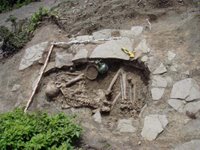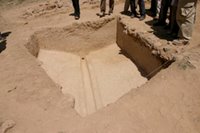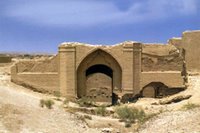Traces of Mithraism Found in Mazandaran Province
 Tehran, 8 June 2006 (CHN) -- Discovery of some Mithraism symbols such as cypress, a goat and an inscription in Sassanid-Pahlavi language and Mithraism architectural style in Kangelou Fortress all have strengthened the theory that this historical monument was used as a worship place during the ancient times. “In Avesta, Zoroastrian’s holly book, Mithra means promise and faith. Mehr (literary meaning love or sun) was one of the creators of Ahura Mazda, God in Zoroastrianism. He was the protector of promise and faith and was lord of light and brightness. We have found some symbols of this religion in Kangelou Fortress,” said Saman Sourtiji, member of academic assembly of Iran’s Archaeology Research Center and head of excavation team in Kangelou Fortress.
Tehran, 8 June 2006 (CHN) -- Discovery of some Mithraism symbols such as cypress, a goat and an inscription in Sassanid-Pahlavi language and Mithraism architectural style in Kangelou Fortress all have strengthened the theory that this historical monument was used as a worship place during the ancient times. “In Avesta, Zoroastrian’s holly book, Mithra means promise and faith. Mehr (literary meaning love or sun) was one of the creators of Ahura Mazda, God in Zoroastrianism. He was the protector of promise and faith and was lord of light and brightness. We have found some symbols of this religion in Kangelou Fortress,” said Saman Sourtiji, member of academic assembly of Iran’s Archaeology Research Center and head of excavation team in Kangelou Fortress.According to Sourtiji, while most of the Mithraism worship places were located inside the caves or places deeper in the ground with the opening towards the sun, Kangelou monument has a quiet different style. “Kangelou is an oval-shaped tower with a 50-square-m
 eter area, constructed in three floors with rubbles, plaster, and mortar. Although most parts of the ceiling have been destroyed over time, what has remained indicates that Sassanid architectural style was used in the construction of the ceilings. A small hole towards the west was identified during the initial excavations in this monument on the base of the tower which means that there must have been a cubbyhole in a lower level of the tower,” added Sourtiji. According to Mithraism beliefs, Mehr was created from a stone, which is why Kangelou monument has a panorama of a huge rock mountain named Khernero from the north. In Pahlavi language, Khernero means the spirit of the sun. Sourtiji believes that former discoveries in this historical site indicate that Kangelou Fortress must have been used as a worship place during the Sassanid era. For example, discovery of some graves with burial gifts such as an opal signet ring with Pahlavid-Sassanid script carved on it, discovery of a gemstone with the design of a six-petal sun carved on it, and another gemstone designed with the image of a cypress tree all may be used as proofs to this claim because all of these designs had a symbolic meaning in Mithraism beliefs.
eter area, constructed in three floors with rubbles, plaster, and mortar. Although most parts of the ceiling have been destroyed over time, what has remained indicates that Sassanid architectural style was used in the construction of the ceilings. A small hole towards the west was identified during the initial excavations in this monument on the base of the tower which means that there must have been a cubbyhole in a lower level of the tower,” added Sourtiji. According to Mithraism beliefs, Mehr was created from a stone, which is why Kangelou monument has a panorama of a huge rock mountain named Khernero from the north. In Pahlavi language, Khernero means the spirit of the sun. Sourtiji believes that former discoveries in this historical site indicate that Kangelou Fortress must have been used as a worship place during the Sassanid era. For example, discovery of some graves with burial gifts such as an opal signet ring with Pahlavid-Sassanid script carved on it, discovery of a gemstone with the design of a six-petal sun carved on it, and another gemstone designed with the image of a cypress tree all may be used as proofs to this claim because all of these designs had a symbolic meaning in Mithraism beliefs.“The design of a goat, which was the symbol of nature and fertility, was carved on one of the discovered jewels. Also the discovered Sassanid-Pahlavi inscription on the opal signet ring says “Farokhi” or “Farahi”, meaning luck or happiness, and belongs to the 4th century AD when Mithraism was spread to a large extent within Iran and Europe,” explained Sourtiji. Mithraism was an ancient mysterious religion prominent from the 1st century B
 C to the 5th century AD. Mithraism apparently originated in the eastern part of today’s Iran around the 7th century BC. It was based on worship to the goddess Mithras and derives from the Persian and Indic god Mithra and other Zoroastrian deities. Mithras was known throughout Europe and Asia by the names Mithra, Mitra, Meitros, Mihr, Mehr, and Meher. The veneration of this God began about 4000 years ago in Persia, where it was soon embedded with Babylonian doctrines. According to Martin A. Larson, an American populist freethinker and religion scholar, in The Story of Christian Origins, Mithraism and Christianity derived from the same sources.
C to the 5th century AD. Mithraism apparently originated in the eastern part of today’s Iran around the 7th century BC. It was based on worship to the goddess Mithras and derives from the Persian and Indic god Mithra and other Zoroastrian deities. Mithras was known throughout Europe and Asia by the names Mithra, Mitra, Meitros, Mihr, Mehr, and Meher. The veneration of this God began about 4000 years ago in Persia, where it was soon embedded with Babylonian doctrines. According to Martin A. Larson, an American populist freethinker and religion scholar, in The Story of Christian Origins, Mithraism and Christianity derived from the same sources.Mithra’s birthday was adopted by Christians in the 4th century AD as the birth of Christ. The archaeology team in Kangelou Fortress hopes to find more traces of Mithraism in this historical monument. If this claim is proven fully, Kangelou will be the most important Sassanid prayer house discovered so far in Mazandaran province.





